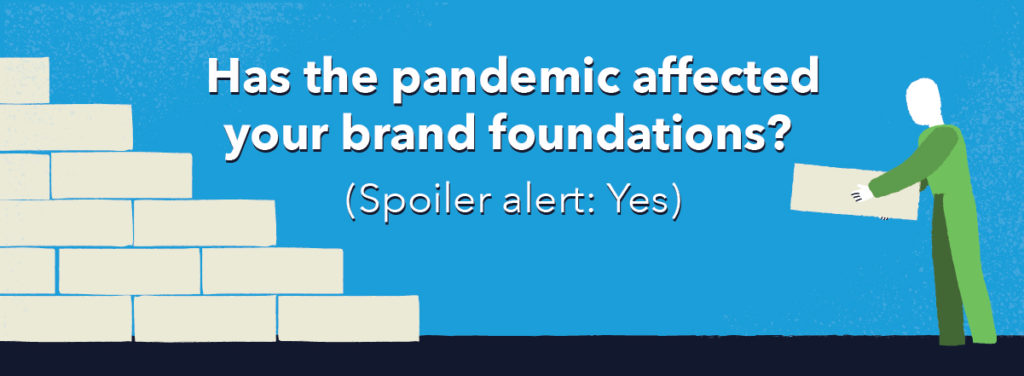(Spoiler alert: Yes)
Evidence is mounting in all areas of life that the pandemic has forced long-term changes in our behavior. We work remotely, we shop online, we’re more focused on health and hygiene, we’re accustomed to at-home entertainment versus nights out — nearly all of these were on the rise already, but the shift has dramatically accelerated, and there are few signs that we’ll return to pre-pandemic “normal.”
You already know this. The question for brands now is, “What are you going to do about it?”
A key aspect of these changes to keep in mind (compared to previously normal changes in consumer behavior) is that these are foundational changes. For example, to go from 40+ hours a week in an office, surrounded by friends and peers, where spontaneous chats and face-to-face interactions were common, to a desk or table in your home, where nearly all meetings are scheduled and isolation is the norm, is a paradigm shift for most working professionals. This is not to paint it as bleek. The point is to show that such changes to a person’s working life are going to cause them to seek and crave different things as consumers. They may want to feel a greater personal connection in a brand experience, or know how companies are looking out for their mental and physical health, or just how quickly a package can arrive at their door.
The market — all markets — have changed. Have you?
In light of the shifts in consumer behavior, now is the ideal time to reflect on your own brand and company. And not just at a superficial level. If, as consumers, all of us have undergone a core transformation in how we interact with and choose products, brands should reexamine their core beliefs, goals, and positioning to ensure both that they reflect who the company is today and are creating meaningful connections with their audiences. In short, now is the time to check your brand foundations.
Because “brand foundations” is an ambiguous term with many variations in practice, here are the key aspects to (re)examine:
- Mission — your company’s reason for being
- Core values — the immutable traits that guide all decisions in pursuit of your mission
- Brand promise — what you can deliver to every customer, every time
- Brand benefits — three to five key points of differentiation for your brand
- Brand positioning — combined statement of the above that defines what you mean to your audience and marketplace
You might be a company that just completed such an exercise within the last year or two. Because these are normally good anywhere from 3-10 years, you might think now is not the time to go back through the time-consuming and sometimes expensive process of brand foundations. If that’s you, to put it plainly, you’re wrong. From the outside in, the people you’re marketing to and those who make up your company have changed. Priorities have likely shifted, pandemic fatigue is challenging everyone, and so much more. And if what matters most to your audience is not what it was the last time you established your brand foundations, then you need to adjust in order to stay meaningful.
So, how do you stay meaningful right now, and how can that be reflected in your brand foundations?
First, ask a lot of questions.
Has your reason for being changed? Does your brand or product(s) play a different role in your customers’ lives than it did before the pandemic? Have the changes in supply chains and consumer habits affected your brand promise and benefits? Has your competitive set changed in the past year?
If the answer is yes to any of these questions, part or all of your brand foundations needs to change. Some companies have shifted to ecommerce or upgraded their ecommerce experience, thus changing their brand benefits. Others have seen competitors unable to navigate the pandemic and go out of business or change their model, possibly altering their brand positioning. Though commonalities are hard to find, the area that has been affected most often is core values.
Core values and characteristics such as trust (or trustworthiness), authenticity, and transparency have all been on a steady rise over the last decade, but the events of 2020 have precipitated a significant increase in concerns about health & wellness and equality — both of which are multifaceted.
Regarding health & wellness, consumers and employees want to know how a brand or company is looking out for their wellbeing. This includes measures and assurances to protect individuals from the spread of COVID-19, as well as greater awareness of mental health. From stipends for fitness equipment to online mental health services to practices that encourage people to disengage to separate work life from home life, many brands are reevaluating the role they play in ensuring the health of consumers and employees — which should find its source in one or more of the company’s core values.
Similarly, 2020 has seen equality become a cornerstone of corporate and consumer values. According to Gartner, a research and advisory company, equality has displaced loyalty as the #1 consumer value. Additionally, inclusion and diversity have risen significantly in consumer values. As they stated, “marketers need to review both short- and long-term brand and communication strategies and realign themes to leverage consumers’ increased focus on social justice and civic engagement.”
No person has been unaffected by the events of 2020. The same goes for brands.
Perhaps the best way to think about examining your brand foundations is an analogy. Imagine you’ve gone through a traumatic year with a seemingly endless parade of challenges (not hard to imagine!) and you run into a friend who appears wholly unaffected by the same experiences.
It could be that the friend has a strategy — that they’ve changed their approach or outlook to how they traverse the world and it’s allowed them to remain essentially the same friend you’ve always known. Or, it could be that they’re basically unaware that anything has been going on and haven’t changed anything about how they approach each day. To consumers, you’re that friend. Most of the time, they don’t know what’s happening with you until they run into you, until they choose to interact with you. When they do, you can choose to show that you too have been affected by the last year and share your changed outlook. Or, you can portray that 2020 hasn’t really affected you.
Of course, there are other ways to sketch this analogy (you could have changed dramatically, for example). The point is to consider not only what has changed within the bounds of your company, but to consider what has widely changed outside the normal bounds of consumer behaviors and concerns.
The world has shifted. If your brand doesn’t reflect that at a foundational level, you’re standing on less solid ground.

Cody Cash is creative director at LimeLight Marketing. Questioning is at the core of Cody’s approach to branding, marketing, and life in general. Asking why and trying to uncover answers has been a driving force in his education and career, leading down a path that has helped a wide range of brands and products in B2B and B2C channels.
Cody earned his bachelor’s degree in philosophy from Missouri State University and Ph.D. in philosophy from the University of Arkansas, specializing in philosophy of mind. Though not necessarily the norm for a career in copywriting and creative direction, philosophy and a philosophical approach have proven to be valuable assets when working in advertising.
After almost two decades spent primarily in food marketing — working with brands such as Bush’s Beans, Frito-Lay, PepsiCo, Nestle, Tyson Foods, Starbucks, and more — Cody moved to LimeLight Marketing in the role of creative director.


